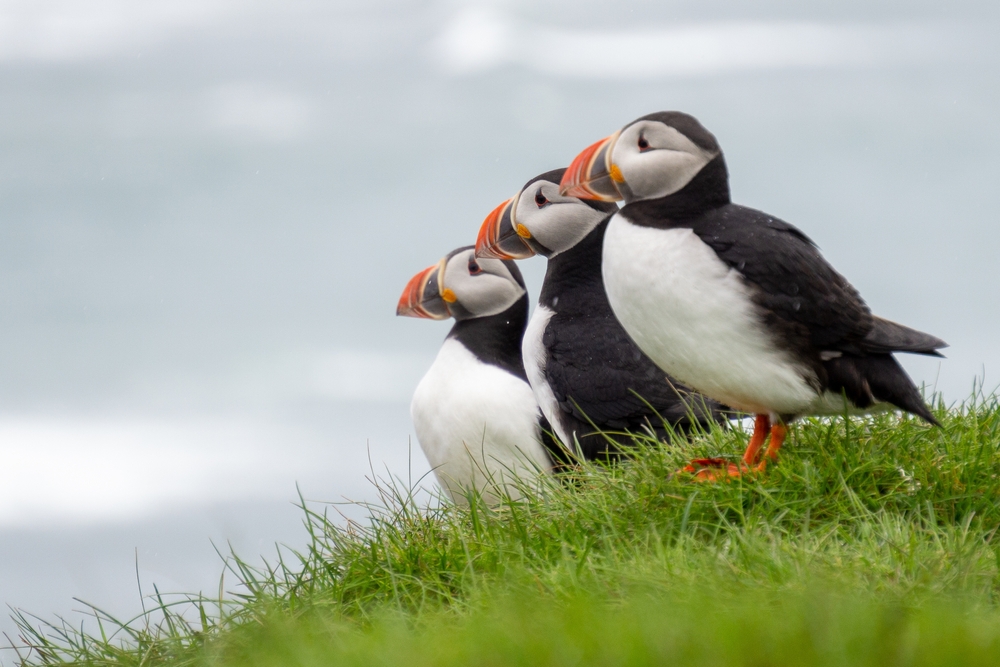Are Puffins Penguins? A Closer Look at These Adorable Seabirds
Posted on Categories Discover Magazine

If you’ve ever seen a puffin, with its striking black-and-white feathers and vivid orange beak, you might have wondered: Are puffins penguins? The short answer is no, but the reasons why are as intriguing as these birds themselves.
Puffins are unique creatures with their own fascinating characteristics. Here, we’ll explore what puffins are, where they live, how they hunt and fly, and why they are increasingly vulnerable to environmental threats — all while clearing up the puffin-penguin confusion for good.
What Is a Puffin?
(Credit: darkntwistyphotography/Shutterstock)
Puffins are small seabirds belonging to the Alcidae family. There are four species of puffins: the Atlantic puffin (Fratercula arctica), the Tufted Puffin (Fratercula cirrhata), the Horned Puffin (Fratercula corniculata), and the Rhinoceros Auklet (Cerorhinca monocerata). These birds are often recognized by their colorful beaks, which become especially vibrant during the breeding season. Despite their small size, puffins are impressive fliers and swimmers, adapted to life on both land and sea.
Depending on the species, puffins range from about 10 to 16 inches tall, making them significantly smaller than most penguins. They typically only weigh a few pounds. Their plumage is predominantly black and white, similar to penguins, but their bright beaks and orange feet set them apart. Puffins are known for their distinctive, almost clown-like appearance, earning them nicknames like “sea parrots” and “clowns of the sea.”
Read More: Why People In Iceland Are Safely Throwing Baby Puffins Off Cliffs
Are Puffins Penguins?
The confusion between puffins and penguins is understandable. Both birds are black and white, have a similar body shape, and are often seen near water. However, they are not closely related.
Puffins belong to the family Alcidae, while penguins belong to the family Spheniscidae. One of the most significant differences between the two is their geographic location. Puffins are found in the Northern Hemisphere, particularly in the North Atlantic Ocean, while penguins are primarily found in the Southern Hemisphere, with many species living in Antarctica.
Another critical distinction between the two is that puffins can fly. Unlike penguins, which are flightless, puffins are excellent fliers, capable of reaching speeds of up to 55 miles per hour by flapping their wings up to 400 times per minute. Puffins also use their strong wings to efficiently swim through water, using a technique similar to penguins.
Read More: 20 Things You Didn’t Know About … Penguins
Where Do Puffins Live?
(Credit: Mark Medcalf/Shutterstock)
Puffins primarily inhabit coastal areas and islands in the North Atlantic Ocean. The largest populations of puffins are in Iceland, which is home to more than half of the world’s Atlantic puffins. Other puffin populations are found in Norway, Greenland, and parts of the United Kingdom, including Scotland and the Faroe Islands.
Puffins prefer rocky cliffs and islands where they can nest in burrows or crevices. Puffins reside and raise their chicks on land, but they spend much of their lives at sea, where they are incredibly agile hunters.
Read More: Top 10 Snow Animals and How They Survive the Cold
What Do Puffins Eat?
Puffins are carnivorous birds that primarily eat small fish, including herring, hake, sand eels, and capelin. They’re also known to occasionally eat squid, shrimp, crabs, and more. Puffins are skilled hunters, using their wings to propel themselves underwater to capture their prey with their sharp beaks.
One of puffins’ most remarkable features is their ability to carry many fish in their beaks at once. They have spine-covered tongues that, when pressed up against the roof of their mouths, help them hold onto their catch while still hunting. This allows them to carry up to 10 or more fish at a time, which is a vital adaptation for feeding their chicks during the breeding season.
Read More: 6 Different Tactics That Animals Use to Prepare for Winter
Can Puffins Fly?
(Credit: Mark Medcalf/Shutterstock)
Puffins can fly, and they do so with remarkable speed and agility. This is one of the key differences between puffins and penguins, as penguins are entirely flightless.
Puffins have short wings that they must rapidly beat — between about 300 and 400 flaps per minute — to stay airborne. Although their flight may appear somewhat clumsy, they are incredibly efficient, especially when traveling long distances between their breeding colonies and feeding grounds.
In addition to flying, puffins are excellent swimmers. They use their wings to “fly” through the water, much like they do in the air, and their webbed feet further improve their ability to catch fish with precision.
Read More: The Origins of Flight, From Birds to Bugs to Planes
Are Puffins Endangered?
Puffins are not currently classified as endangered, but they are considered vulnerable in some areas. The Atlantic puffin is listed as “Vulnerable” by the International Union for Conservation of Nature (IUCN) due to declining populations in certain regions, which is at least partly attributed to increased mortality from ingesting plastic waste. Overfishing, which reduces their food supply, and climate change, which affects their breeding and feeding habitats, are two other major factors contributing to their decline.
In addition to these threats, puffins face other challenges from human activities such as pollution, habitat destruction, and hunting in some parts of the world. Fortunately, conservation efforts are underway in various regions to protect puffin populations, including establishing protected breeding areas and enacting measures to reduce overfishing.
Whether they’re flying at breakneck speeds or diving for fish in the ocean, these little seabirds are a marvel of nature. So, if you ever get the chance to see a puffin in the wild, be sure to take a moment to watch it in action.
Read More: 5 Vulnerable Animal Species That May Surprise You
Jake Parks is a freelance writer and editor who specializes in covering science news. He has previously written for Astronomy magazine, Discover Magazine, The Ohio State University, the University of Wisconsin-Madison, and more.